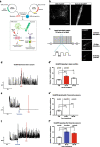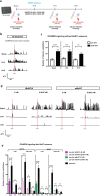Optogenetically controlled human functional motor endplate for testing botulinum neurotoxins
- PMID: 34865655
- PMCID: PMC8647380
- DOI: 10.1186/s13287-021-02665-3
Optogenetically controlled human functional motor endplate for testing botulinum neurotoxins
Abstract
Background: The lack of physiologically relevant and predictive cell-based assays is one of the major obstacles for testing and developing botulinum neurotoxins (BoNTs) therapeutics. Human-induced pluripotent stem cells (hiPSCs)-derivatives now offer the opportunity to improve the relevance of cellular models and thus the translational value of preclinical data.
Methods: We investigated the potential of hiPSC-derived motor neurons (hMNs) optical stimulation combined with calcium imaging in cocultured muscle cells activity to investigate BoNT-sensitivity of an in vitro model of human muscle-nerve system.
Results: Functional muscle-nerve coculture system was developed using hMNs and human immortalized skeletal muscle cells. Our results demonstrated that hMNs can innervate myotubes and induce contractions and calcium transient in muscle cells, generating an in vitro human motor endplate showing dose-dependent sensitivity to BoNTs intoxication. The implementation of optogenetics combined with live calcium imaging allows to monitor the impact of BoNTs intoxication on synaptic transmission in human motor endplate model.
Conclusions: Altogether, our findings demonstrate the promise of optogenetically hiPSC-derived controlled muscle-nerve system for pharmaceutical BoNTs testing and development.
Keywords: Botulinum neurotoxins; Calcium indicators; Functional; Human-induced pluripotent stem cells; Motor endplate; Optogenetics.
© 2021. The Author(s).
Conflict of interest statement
The authors declare that they have no competing interests. CN and JDL are IPSEN employees.
Figures




Similar articles
-
hiPSC-Derived Neurons Provide a Robust and Physiologically Relevant In Vitro Platform to Test Botulinum Neurotoxins.Front Pharmacol. 2021 Jan 14;11:617867. doi: 10.3389/fphar.2020.617867. eCollection 2020. Front Pharmacol. 2021. PMID: 33519485 Free PMC article.
-
Split luciferase-based assay to detect botulinum neurotoxins using hiPSC-derived motor neurons.Commun Biol. 2023 Jan 30;6(1):122. doi: 10.1038/s42003-023-04495-w. Commun Biol. 2023. PMID: 36717690 Free PMC article.
-
Analysis of Motor Neurons Differentiated from Human Induced Pluripotent Stem Cells for the Use in Cell-Based Botulinum Neurotoxin Activity Assays.Toxins (Basel). 2020 Apr 25;12(5):276. doi: 10.3390/toxins12050276. Toxins (Basel). 2020. PMID: 32344847 Free PMC article.
-
Emerging Opportunities in Human Pluripotent Stem-Cells Based Assays to Explore the Diversity of Botulinum Neurotoxins as Future Therapeutics.Int J Mol Sci. 2021 Jul 14;22(14):7524. doi: 10.3390/ijms22147524. Int J Mol Sci. 2021. PMID: 34299143 Free PMC article. Review.
-
Action of botulinum neurotoxins in the central nervous system: antiepileptic effects.Neurotox Res. 2006 Apr;9(2-3):197-203. doi: 10.1007/BF03033939. Neurotox Res. 2006. PMID: 16785118 Review.
Cited by
-
Recent Developments in Botulinum Neurotoxins Detection.Microorganisms. 2022 May 10;10(5):1001. doi: 10.3390/microorganisms10051001. Microorganisms. 2022. PMID: 35630444 Free PMC article. Review.
-
Botulinum Toxin Treatment of Adult Muscle Stem Cells from Children with Cerebral Palsy and hiPSC-Derived Neuromuscular Junctions.Cells. 2023 Aug 15;12(16):2072. doi: 10.3390/cells12162072. Cells. 2023. PMID: 37626881 Free PMC article.
-
Unlocking the Complexity of Neuromuscular Diseases: Insights from Human Pluripotent Stem Cell-Derived Neuromuscular Junctions.Int J Mol Sci. 2023 Oct 18;24(20):15291. doi: 10.3390/ijms242015291. Int J Mol Sci. 2023. PMID: 37894969 Free PMC article. Review.
-
Stress exposure affects amyotrophic lateral sclerosis pathogenesis via PI3K/Akt and focal adhesion pathways: evidence from three experimental models.Sci Rep. 2025 May 21;15(1):17583. doi: 10.1038/s41598-025-02167-9. Sci Rep. 2025. PMID: 40399476 Free PMC article.
-
The Neurotoxicity of Vesicles Secreted by ALS Patient Myotubes Is Specific to Exosome-Like and Not Larger Subtypes.Cells. 2022 Mar 1;11(5):845. doi: 10.3390/cells11050845. Cells. 2022. PMID: 35269468 Free PMC article.
References
-
- Rossetto O. Botulinum toxins: molecular structures and synaptic physiology. In: Jabbari B, editor. Botulinum toxin treatment in clinical medicine. Cham: Springer International Publishing; 2018. pp. 1–12.
Publication types
MeSH terms
Substances
LinkOut - more resources
Full Text Sources
Research Materials

